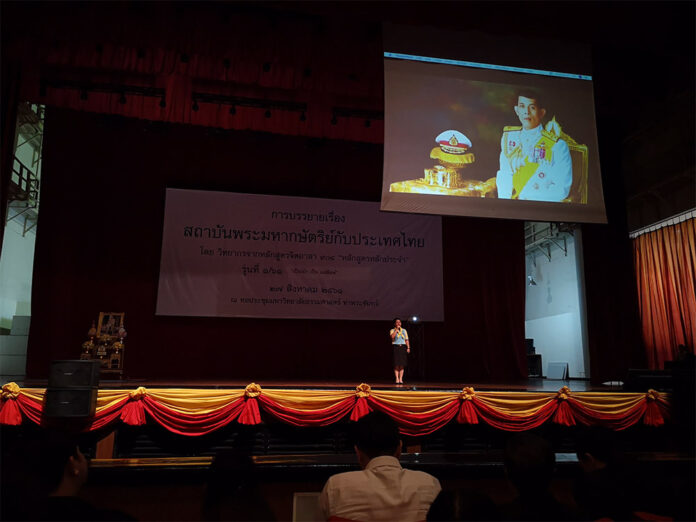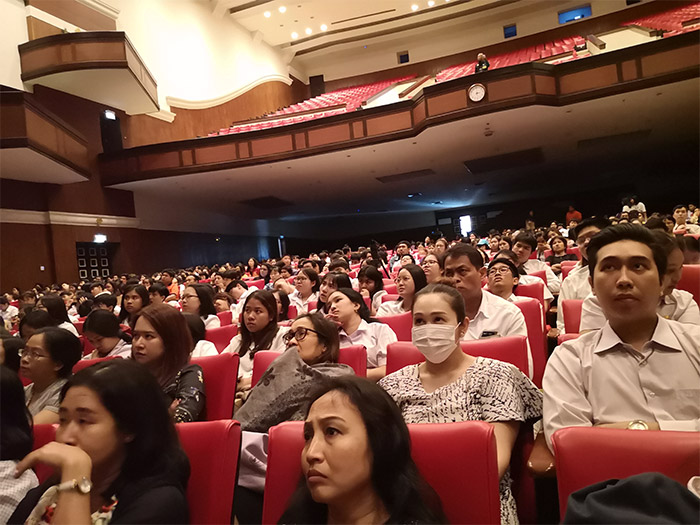
BANGKOK — Eight people, six women and two men wearing yellow neckerchiefs and blue baseball caps, marched on stage with the precision of a military parade. Taking turns speaking over the next two hours, they described the benevolence of the Chakri dynasty in bringing peace and happiness to the people of Thailand.
They addressed a room of about 1,000 Thammasat University students Monday at what was the university’s first ever lecture by a royalist volunteer unit expounding love and loyalty to the king and monarchy.
“Please fill up all the seats in the front rows,” a volunteer urged in an orange polo shirt. Attendees were asked to stand up and pay respects to the portrait of the king and wait for formal photos to be taken by the unit’s photographers.
What followed was a message about how an ideal society has been achieved through harmony, unity and devoted kings.
That came after a slight delay for organizers to replace the portrait of King Vajiralongkorn, who ascended the throne under two years ago, with a larger one. University rector Kesinee Withoonchart then prostrated herself on the ground before it.
A banner proclaimed the event’s organizers – Volunteers Unit 904. The number 904 is derived from the former radio call sign of the king before he was king. His father, the late King Bhumibol, was referred to as No. 1; his mother, Queen Sirikit, as No. 2; and his majesty’s older sister, Princess Ubonrat, as No. 3.
The eight volunteers, drawn from the armed forces and police, took turns reciting a practiced presentation set to a large video display to right of stage center.
The Message
 A speaker announced early on that due to time limitations, they wouldn’t be able to cover every deed of past and present kings. They focused on five of the 10 kings of the Chakri Dynasty: Ramas I, III, V, IX and the current monarch, Rama X.
A speaker announced early on that due to time limitations, they wouldn’t be able to cover every deed of past and present kings. They focused on five of the 10 kings of the Chakri Dynasty: Ramas I, III, V, IX and the current monarch, Rama X.
Rama I – who founded Bangkok and ruled from 1782 to 1809 – was extolled for his successful defense of Siam against a larger, invading Burmese army and the happiness of his people.
“Everyone is happy under the grace of the Chakri Dynasty,” a female Unit 904 volunteer said from the stage before a projected cartoon of the war with Burma.
The narrative then skipped to Rama III and his role and foresight in accumulating wealth for the nation through maritime trade, endowing the royal treasury with bags of coins.
Moving on to Rama V, or King Chulalongkorn, the speakers described how Siam narrowly escaped colonial rule in 1893 and had to cede some territory after a French naval blockade led to a deadly confrontation on the Chao Phraya river. They described Rama V embarking on a diplomatic maneuver by forging close ties with Tsarist Russia.
Another female speaker offered a dramatic account of how sad the king became at the sight of horse-drawn carriages laden with the same bags of coins saved by his uncle, whose final words warned of Western aggression, to pay 3 million francs in reparations for the deaths of French soldiers.
“On that day, Siam shed tears as the sound of horse carriages made deep marks on the path due to the weight of the coins being transported,” a woman told the audience.
“Did you know that we lost territories but never our sovereignty?” she added.
Rama V was praised for modernizing Siam by introducing the railway, tap water, hospitals, schools and telegram services, as well as ending slavery.
From Rama V, the history of Chakri kings jumped to Rama IX, the late father of the current king, without mention of the 1932 revolt that changed the kingdom to a constitutional monarchy.
At one point, everyone in the audience was asked to cover their right eye with their right hand to imagine the difficulties faced by Rama IX, who lost an eye in a road accident at a young age.
“Everyone please raise your right hand and cover your right eye and look around. This is how his [late] majesty worked for most of his life,” said yet another female lecturer, who earlier said King Bhumibol worked tirelessly for the benefit of the Thai people “without holidays, without overtime pay and without a bonus.”
The speaker later recalled the day king Rama IX passed away nearly two years ago and added that she still couldn’t believe it, even now.
When talking about Rama IX, speakers stressed his close ties to his son, the current king.
The lecture then addressed his reign, which began in late 2016. The current king, one of the women noted, followed his later father closely in a low-profile manner to learn from him as images of the king accompanying his late father were projected.
The goal of the current reign is to continue and progress the works of his late father, the speaker said, adding that His Majesty wished for people to cultivate a good attitude toward their county, be united and comport themselves as good citizens under the slogan “We do good with our hearts.”
After the presentation wrapped, a question-and-answer session saw no takers from the audience. Seeking feedback on the first such session at Thammasat, assessment forms were distributed toward the end of the lecture. It asked what benefits were gained by listening to the presentation and how one might relay its information to others.
The event ended with people being asked to stand for a song newly written for the new king and the traditional royal anthem.















































